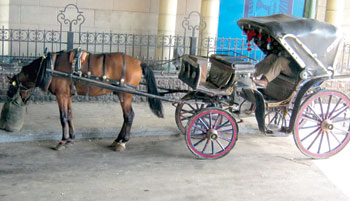Gilbert Wandera was in Egypt for the Nile soccer tournament, but took time off to sample small pleasures of the lively Cairo
Egypt’s capital city, Cairo has always attracted visitors since the time of the mamluks. The great pyramids of Giza on the very edge of the city have been on the lips of many a poet.
As long as you are willing to loosen your senses and lose yourself, then only will you appreciate the beautiful, hectic, crowded, surprising and enchanting sweetness of Cairo.
Unlike in many cities in Muslim countries, Cairo is more liberal and the women are not restricted to wearing hijabs. In fact, a good number of the young women have embraced modernity and comfortably dress in what would be termed as Western attire.
Cairo is a city of 17million people but the Government has done a good job in ensuring that it does not come to a standstill due to incessant traffic snarl-ups. Despite the good road network, one is advised to leave for their appointments at least an hour early.
Huge highways, byways and bypasses are common feature in Cairo and these help ease movement. In other parts of the city the Government has built huge tunnels with roads under-ground for distances of up to five kilometres.
Though I was here for the Nile Basin tournament I could not help compare Cairo to Nairobi. Like Nairobi, it is an amazing city full of life and movement and it is that way almost 24 hours a day, with the noisy hootings and merchants selling their wares and services.
Transportation
Cairo is teaming with buses, trams, metro, underground and taxis. Using public transportation requires patience and tolerance as there are no strict timetables and they are often crowded.
The Government has heavily subsidised fuel prices, making public transportation affordable for all. A passenger, whether in a bus or train, pays a standard fee on all routes.
Cairo streets are a cacophony of hooting as impatient drivers force their way through. According to one taxi driver, driving here is like going to war. One has to fight his way through the chaos and make sure they reach their destination intact. It takes a lot of self-discipline not to shout and curse. A visitor from another place would be shocked, but coming from Nairobi’s Eastlands, I must confess I have seen worse.
 |
Horse-driven chariots are some of the means of transport available. [PHOTOS: GILBERT WANDERA / STANDARD] |
What I also found strange is the presence of police and other security personnel though unarmed. The police in their black uniforms are virtually stationed on every corner of the vast city. They freely mingle with the people and are not viewed with suspicion, as is the case back home. There were times they outnumbered civilians during the soccer matches.
At the end of each match, the policemen made a security ring around all the teams. The Egyptian team was the most guarded as young enthusiastic fans always wanted to carry their national players shoulder high after every game.
Pyramids
Stay informed. Subscribe to our newsletter
It’s every visitor’s wish, once in Cairo, to tour the pyramids in Giza situated about 50 kilometres outside the city. Standing majestically in the middle of the desert are tens of pyramids stretching over a very huge area. Security is tight at the gates and no television cameras are allowed inside apparently in a bid to protect the pyramids from being too much exposure that might limit visitors.
A thorough security check is mandatory after which the tour guides take over. The largest of the pyramids is also known as the Great Pyramid of Giza or Pyramid of Khufu. It is the oldest and regarded as one of the Seven Wonders of the World.
According to Ahmed, a tour guide, the pyramid has three million stones in total.
The foundation stones weigh eight tonnes each, while the rest weigh between three and five tonnes each. The pyramid was originally 148m high but over time has lost nine meters due to adverse weather conditions.
Major attraction
It’s a wonder the pyramid has not lost its glamour and continues to attract visitors. According to Ahmed, it took 100,000 men working over a period of 20 years to build this particular pyramid that held the remains of Pharaoh Khufu.
"Building the pyramid was a lot of work and many people died in the process," he explains. Besides the great pyramid is a much smaller one built by Khufu’s successor and our guide explains that this may be because the incoming pharaoh may have been more sympathetic to his subjects hence did not see the need to build a huge structure as his tomb.
Apart from just having a look at the pyramids, many more people also pay to see the actual tombs inside. The caretakers print just a few tickets, which are always finished by 9am every morning.
Another interesting tourist attraction is a cruise on the River Nile aboard the ‘Nile Pharaoh’ ferry. One is welcomed aboard by waiters dressed in pharaoh-like attire. For one and half hour, you will have your dinner while being entertained by a bevy of Egyptian belly dancers.
Cairo has many five star hotels strutting the width and breathe of the city with various guesthouses and apartments adding on to the available accommodation.
According to Mayassar Mazjob a Sudanese who has stayed in Cairo for the last three years, it is much cheaper to put up in apartment than stay in the hotels.
"The apartments charge you per week and what you pay may be equivalent to just two days of the cost of putting up in a hotel," he explains.
Furthermore the apartment gives a home atmosphere where the resident has to cook the meals. In a bid to decongest the city, the Government is building massive apartments and bungalows outside Cairo, which is straddled by high-rise apartments.
 The Standard Group Plc is a
multi-media organization with investments in media platforms spanning newspaper
print operations, television, radio broadcasting, digital and online services. The
Standard Group is recognized as a leading multi-media house in Kenya with a key
influence in matters of national and international interest.
The Standard Group Plc is a
multi-media organization with investments in media platforms spanning newspaper
print operations, television, radio broadcasting, digital and online services. The
Standard Group is recognized as a leading multi-media house in Kenya with a key
influence in matters of national and international interest.
 The Standard Group Plc is a
multi-media organization with investments in media platforms spanning newspaper
print operations, television, radio broadcasting, digital and online services. The
Standard Group is recognized as a leading multi-media house in Kenya with a key
influence in matters of national and international interest.
The Standard Group Plc is a
multi-media organization with investments in media platforms spanning newspaper
print operations, television, radio broadcasting, digital and online services. The
Standard Group is recognized as a leading multi-media house in Kenya with a key
influence in matters of national and international interest.










